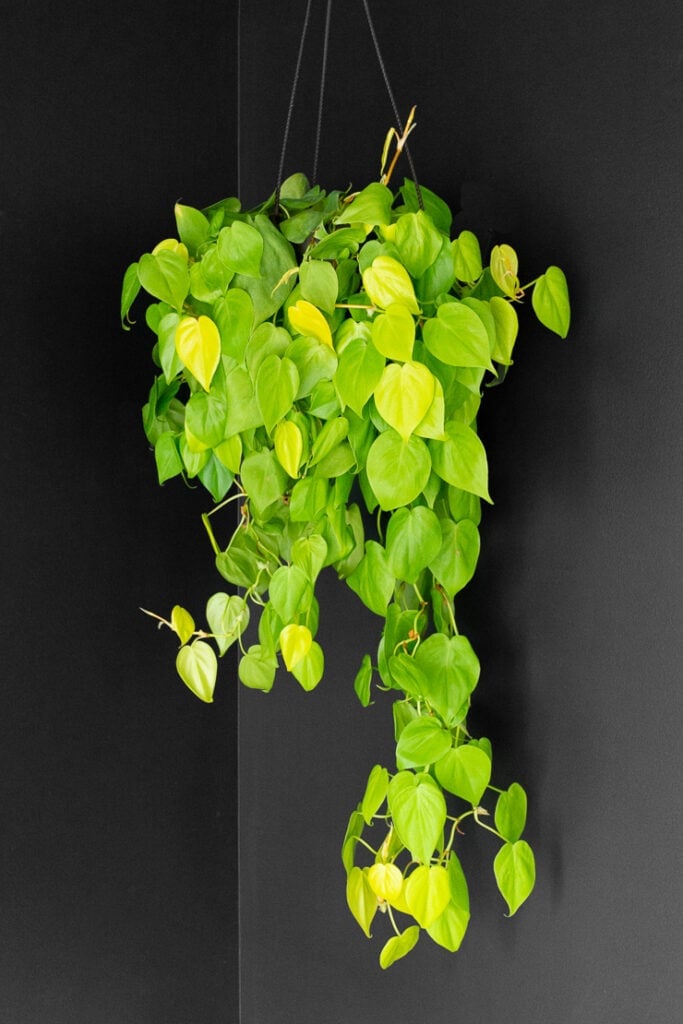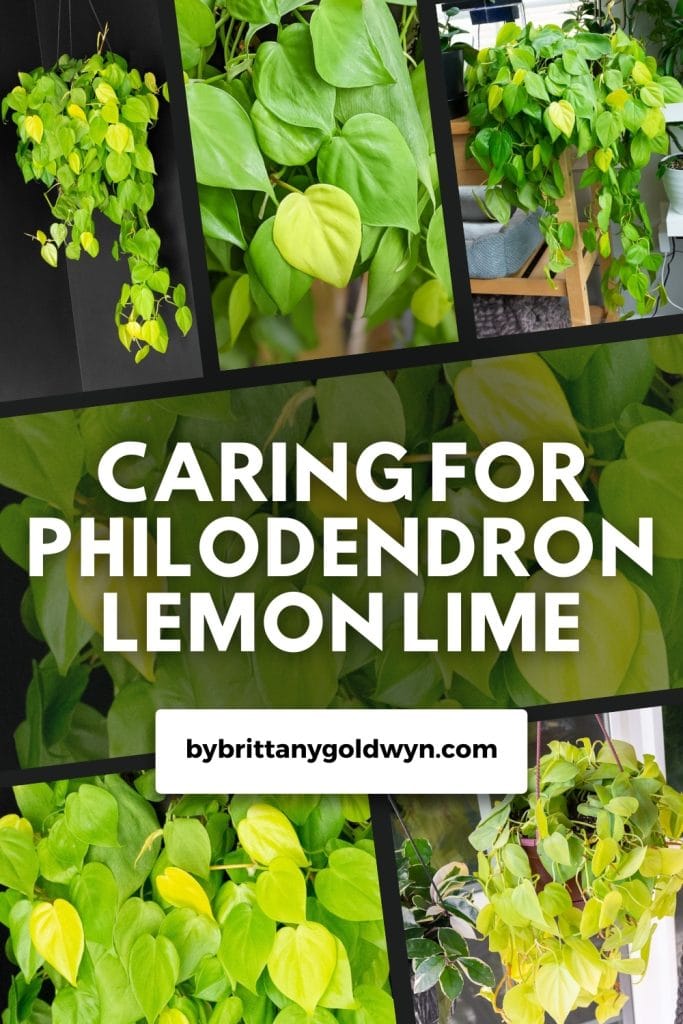Learn about philodendron lemon lime—a wonderful and easy to care for plant.
Philodendron lemon lime care
I wrote a long time ago about heart-leaf philodendron care, and today I’m writing about another type of heart-leaf philodendron: the philodendron lemon lime! They are best known for their vibrant lemon-lime, highlighter-colored leaves that are heart-shaped and thin.
Their leaves can also appear pink at first but turn neon yellow and green as they mature. Philodendron lemon lime care is straightforward, and it’s an easy plant to maintain. Read on for more tips about caring for this plant—all based on my first-hand experience helping it thrive.

Philodendron lemon lime care overview
- Known for its vibrant, highlighter-colored, heart-shaped leaves.
- Created via tissue culture in a lab from a mutation in philodendron hederaceum.
- Bright indirect light is best; direct sunlight can damage foliage; lower light levels can be okay, but monitor for signs of stress.
- Any well-draining indoor potting mix will work.
- Allow the top half of the soil to dry out; when watering, water deeply, allowing the excess water to drain out.
- Thrives in temperatures 65-80 degrees F; does well in average household humidity but will appreciate extra humidity.
- Easily propagate via stem cuttings.
- Contains calcium oxalate crystals; considered mildly toxic if ingested.
Background & lab creation
Philodendron lemon lime is also known as the philodendron hederaceum ‘lemon lime.’ Philodendrons are tropical plants that hail from Central and South American rainforests. The lemon lime is a relatively new cultivar that was discovered and patented in a lab in China in 2004.
According to patent research on Google, it looks like it was discovered by a Malaysian citizen named Tai Yam. He noted an interesting mutation in the philodendron hederaceum (the green heart-leaf philodendron) and initiated a tissue culture to try to reproduce it.
The reproduction was successful, and the plant has since been reproduced through propagation. Generations of this plant have proven that the lemon-lime color derived from the original mutation is stable (aka, it won’t revert back to the original green color).


How much light does it need?
Like most philodendrons, lemon lime grows best in bright indirect light. The best place being a few feet away from a window that gets a lot of sunlight. Outside, you want somewhere with either dappled sunlight, morning sunlight only, or bright shade.
Placing your plant in direct sunlight will burn the foliage and permanently damage it. I had mine outside on my covered patio one summer. One day I took it down to water and set it down to drain on the deck. I forgot about it, and part of the plant eventually was in direct sun as the day went on. The leaves fried and I had to trim them off.
On the opposite end of things, part of what makes the philodendron lemon lime easy to maintain is that it can grow even in lower lighting. But keep an eye out for droopy leaves as this could mean it needs more sun exposure. Less light will also likely mean less water.


What soil is best?
The philodendron lemon lime isn’t too picky about soil, and most standard indoor or houseplant potting mixes will suffice. However, the priority should always be good drainage. The soil also needs to be loose enough to allow some air to get to the roots.
I usually add an extra handful of coco coir to potting mixes to achieve this. Avoid mixes that are overly sandy (like succulent soils). Although they improve drainage, it can compress and harm its roots. For more on different soil amendments, check out my houseplant soil 101 article.


For more, check out my care guides for the philodendron birkin, philodendron micans, and silver sword philodendron!
How much water does it need?
You should allow the top half of the soil to dry out before watering again. The proper way to water is by drenching the soil and letting the water drain all the way through. For my plants that aren’t outside, I like to achieve this level of deep watering by putting plants in the sink or in a tub.
If you aren’t watering your plant enough, you might notice droopy, brown leaves or the plant’s oldest leaves beginning to yellow and die off. If you are watering too much, your plant may begin yellowing off other leaves. The yellow color from overwatering will be much less vibrant than the intense healthy yellow-green color.

Temperature & humidity needs
The optimal temperature range for the philodendron lemon lime plant is anywhere between 65 and 80 degrees Fahrenheit. That being said, it will grow just fine in most indoor environments. This plant is very sensitive to low temperatures, though, so you’ll want to move it away from cold, drafty windows during winter. Otherwise it will wilt.
Believe it or not, humidity is not a huge factor in philodendron lemon lime care. Although it’s a tropical plant, it grows well in average household humidity levels. You won’t need to make any special accommodations for this beauty. Of course added humidity doesn’t hurt, and the plant may thank you with larger leaf growth.


Philodendron lemon lime propagation
Philodendron lemon lime is very straightforward and easy to do! It’s a lot like propagating pothos cuttings, and this plant is also a good candidate for water propagation. You’ll want to do this during its growing season, so spring or summertime.
You can also skip the water rooting step and put the cutting directly in soil. For this method, I’d recommend some sort of rooting hormone to help jumpstart root growth. Place the cutting with a node a few inches deep in moist, rich soil.
Pick a healthy stem with several leaves (aka nodes, that’s where the leaf meets the stem) and make a cut. Pop it in some water and refresh the water every week or so. Once you have some nice root growth, you can transplant the cutting to soil. Keep it moist while the water roots convert to soil roots.
Keep out of direct light, and water frequently. You should notice roots develop in 2-3 weeks, and a new stem in about 2-3 months. You can also gently tug on the cutting after a few weeks to see if roots have developed.


Lemon lime vs. neon pothos
While doing your research, it can be easy to confuse certain plants because some of them look so similar! Not to mention, it gets tricky when nurseries use a variety of common names. The philodendron lemon lime and neon pothos are a pair that are commonly confused, and for good reason. They are both neon highlighter yellow-green!
The best way to tell the difference is in their leaves. A young philodendron lemon lime plant’s new leaves will appear more pink, while new neon pothos leaves are a very light yellow-green. I’ve noticed that the stems on the lemon lime plant are also a bit thinner than on the pothos plants.
They also have different textures. The lemon lime leaves are very thin and smooth, while the neon pothos leaves have more grooves and texture. Running your finger along the top of a leaf will quickly tell you whether it is a philodendron lemon lime or a pothos.


Safety & toxicity
Philodendrons are considered toxic if ingested because they contain calcium oxalate crystals. These can lead to gastrointestinal irritation, vomiting, nausea, drooling, and more when ingested. So it’s best to keep this one up and out of reach if your pets or kids are nibbly.
However, having philodendrons in your home is perfectly safe. They don’t pose a risk if you’re just touching them, including pruning, repotting, etc.
In conclusion…
Philodendron lemon lime is a vibrant and easy addition to any indoor space. Its neon yellow-green, heart-shaped leaves make it a standout choice. Remember, bright indirect light, well-draining soil, and proper watering are key to keeping this plant thriving. Let me know in the comments below if you’ve care for this one—and happy planting!
Pin my guide!


Brittany is a seasoned DIY home and garden expert, running a creative brand since 2014 that inspires others with approachable plant care guides, sustainable gardening how-tos, and DIY projects. She is a master gardener and certified project manager who has completed extensive coursework in the art and science of growing your own plants. Her favorite thing to do is inspire you! Learn more about her here.

Leave a comment